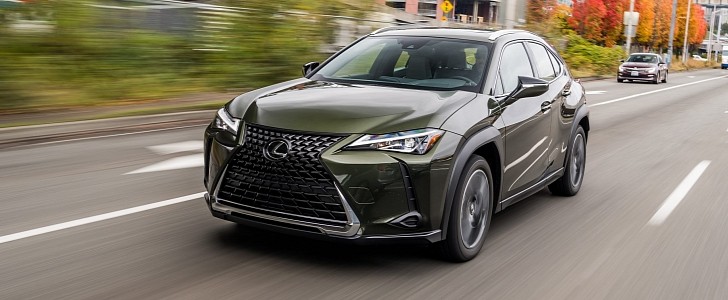Introduced three years ago, the UX arrived at Lexus retailers for the 2019 model year with subcompact dimensions and two powertrain options. Although it makes a lot of sense in the Japanese automaker’s lineup, the sharp-styled crossover never took off in the U.S. in terms of sales.
Lexus moved 16,962 units last year, which is a shameful result in comparison to the compact NX and mid-size RX siblings. In order to revitalize sales, the company decided to improve the UX with new colors both inside and out.
Grecian Water, Sonic Chrome, and Cadmium Orange will be added to the exterior palette for the 2022 model year, and color-keyed overfenders will be available on the Premium, Luxury, and F Sport. On the inside, Grecian Water can be paired with three options: Black, Birch, and Birch with Lapis.
Standard bi-LED headlights or available three-projector LED headlights are complemented by a block-shaped mesh pattern for the spindle grille, and full-width LED taillights project a distinctive nighttime signature. The F Sport brings the point home with even fancier motifs that include L-shaped pieces for the grille, a specific front bumper, and Jet-Black trim for the moldings.
The standard engine, which is only available with front-wheel drive, is a four-cylinder lump that develops 169 horsepower and 151 pound-feet (205 Nm) of torque, adequate resources for a vehicle with this footprint. The Atkinson-cycle plant is connected to a 10-speed transmission the marketing people refer to as Direct Shift CVT. It’s a bunch of nonsense, to be frank, and I’ll tell you why. Whatever you choose to call a CVT, a continuously variable transmission doesn’t have real gears like an auto but pulleys and belts.
Higher up the spectrum, the hybrid powertrain is the one to choose because it features all-wheel drive and promises better efficiency. How much better? Think 39 miles to the gallon (6.0 liters per 100 kilometers) on the combined driving cycle compared to 32 miles per gallon (7.3 liters per 100 kilometers).
Grecian Water, Sonic Chrome, and Cadmium Orange will be added to the exterior palette for the 2022 model year, and color-keyed overfenders will be available on the Premium, Luxury, and F Sport. On the inside, Grecian Water can be paired with three options: Black, Birch, and Birch with Lapis.
Standard bi-LED headlights or available three-projector LED headlights are complemented by a block-shaped mesh pattern for the spindle grille, and full-width LED taillights project a distinctive nighttime signature. The F Sport brings the point home with even fancier motifs that include L-shaped pieces for the grille, a specific front bumper, and Jet-Black trim for the moldings.
The standard engine, which is only available with front-wheel drive, is a four-cylinder lump that develops 169 horsepower and 151 pound-feet (205 Nm) of torque, adequate resources for a vehicle with this footprint. The Atkinson-cycle plant is connected to a 10-speed transmission the marketing people refer to as Direct Shift CVT. It’s a bunch of nonsense, to be frank, and I’ll tell you why. Whatever you choose to call a CVT, a continuously variable transmission doesn’t have real gears like an auto but pulleys and belts.
Higher up the spectrum, the hybrid powertrain is the one to choose because it features all-wheel drive and promises better efficiency. How much better? Think 39 miles to the gallon (6.0 liters per 100 kilometers) on the combined driving cycle compared to 32 miles per gallon (7.3 liters per 100 kilometers).










